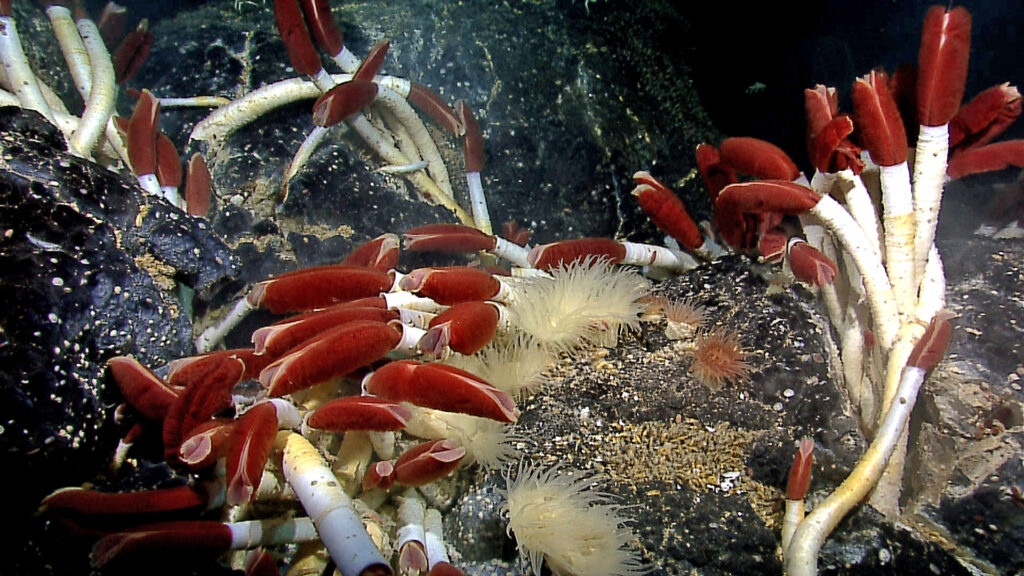
As an undergraduate studying marine zoology I found deep-sea hydrothermal vents absolutely fascinating! The sheer wonder at the bustling life that could evolve, survive and indeed thrive in such hostile environments: 2500-4000 meters beneath the sea, over 290 bars of pressure, expanses of darkness and emptiness where sunlight is but a memory, and then the large tower like structures of “smokers” – vents emitting water with temperatures of over 400C, sustaining marine ecosystems based not on photosynthesis but on chemosynthesis harvested from the vents. Mind-blowing. The only topic that fascinated me marginally more was parasitology. I made my choice on which topic to pursue in my research career but recently I was really delighted to come across this research article on Parasite diversity at isolated, disturbed hydrothermal vents.
Are there parasites in hydrothermal vent ecosystems?
Parasites have been found at hydrothermal vents, however, there have been very few studies looking at their diversity, abundance and life history traits. In this study, researchers collected 2,215 potential hosts of 51 species from 11 vent sites, including a range of thermal zones and substrate types. These were dissected, and tissues and gut contents examined under a microscope. The study relied on taxonomists and DNA barcoding to identify the parasites. If there was uncertainty over whether a symbiont was a parasite or not the following criteria were used:
- was it exclusively found living in close association with a potential host?
- did it have specialized morphology for feeding or attachment?
- was it embedded within host tissues and have evidence of feeding on host tissues?
Over 5,800 parasite samples were recovered. These were from 12 adult metazoan parasite morphogroups and nine larval morphogroups in five of the major marine parasite taxa included in this study. The entire dataset can be accessed through here.
Comparing parasite richness in extreme settings
Parasite diversity is thought to be driven by habitat disturbance and isolation. In addition, life history traits such as direct or indirect life cycles may be important factors on what types of parasites thrive in disturbed or extreme habitats. The hypothesis proposed is that indirect life cycles are less likely to establish and thrive in highly disturbed and isolated communities, the expected lower diversity of potential host fauna limiting their establishment. Hydrothermal vents offer a great system to study how parasite richness and diversity are impacted by disturbance and isolation. The researchers compared parasite richness and diversity between these hydrothermal vent sites and two other benthic marine ecosystems: kelp forests and intertidal lagoon sandflats. They focused on four host groups: crustaceans, fishes, mollusks and polychaetes, and focused on the following metazoan parasites: Acanthocephala, Cestoda, Copepoda, Isopoda, Monogenea, Nematoda, Rhizocephala and Trematoda.

They found that parasite richness within host species was not significantly different between ecosystems. However, the total parasite richness was lower in vents compared to the kelp forests and intertidal sandflats. Interestingly, parasites with indirect life cycles, which were expected to be scarcer in the hydrothermal vent habitats, were in fact relatively abundant due to the number of trematode parasites found infecting host groups living on hydrothermal vents. However, other parasite taxa with indirect life cycles were missing or scarce (cestode and nematode groups). The authors suggest this may be due to the trematode life cycle stage that undergoes asexual, clonal reproduction, allowing for rapid and sustained dispersal of trematode larvae from the infected intermediate host. This particular life cycle trait is missing from cestodes and nematode groups, perhaps explaining their absence/low prevalence in these disturbed and isolated hydrothermal vent habitats.
Check out this excellent BBC Earth interview with the lead researcher of the article and other researchers working on deep-sea parasites, including a fun live dissection and parasite collection:
I really enjoyed reading this study and watching the video and I hope more research is done to look at marine parasites around deep-sea hydrothermal vents. Considering that theories have been put forward about the origin of life being linked to hydrothermal vents, should we wonder what this means for the origin of parasitism?

Comments